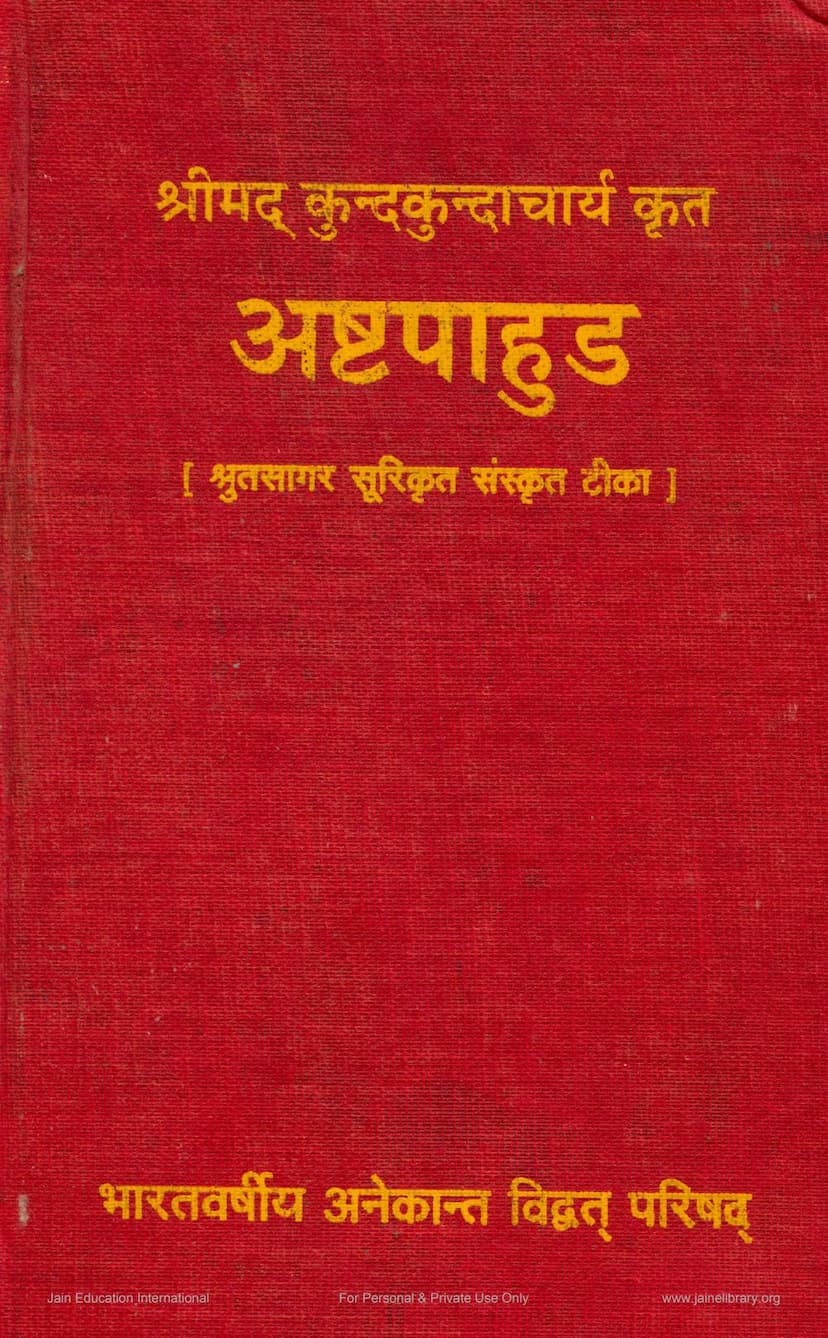Ashtpahud
Added to library: September 1, 2025

Summary
Here's a comprehensive summary of the Jain text "Ashtpahud" (अष्टपाहुड) based on the provided information:
Book Title: Ashtpahud (अष्टपाहुड) Author: Kundkundacharya (कुन्दकुन्दाचार्य) Commentary: Shrutsagarsuri (श्रुतसागर सूरि) (Sanskrit commentary) Translation/Adaptation: Pannalal Sahityacharya (पन्नालाल साहित्याचार्य) (Hindi translation) Publisher: Bharat Varshiya Anekant Vidwat Parishad (भारतवर्षीय अनेकान्त विद्वत् परिषद्)
Overall Summary:
The provided text is a detailed introduction and partial summary of the Jain scripture "Ashtpahud" (Eight Sections or Eight Teachings), authored by the revered Acharya Kundakund. The text serves as a guide to understanding the profound spiritual and ethical principles of Jainism, as expounded by Kundakundacharya, with the added benefit of a Sanskrit commentary by Shrutsagar Suri and a Hindi translation by Pannalal Sahityacharya.
The introduction emphasizes the ancient origins of Shraman (ascetic) culture in India, predating Vedic culture, and highlights Jainism's foundational role in promoting spiritual ideals like labor, self-control, and renunciation. It traces this tradition from the first Tirthankar, Lord Rishabhdev, to the last, Lord Mahavir.
A significant portion of the text is dedicated to establishing the historical and spiritual authority of Acharya Kundakund. It discusses his numerous names (Kundkund, Padmanandi, Vakragriva, Elacharya, Gridh Pichchha), his mastery of the twelve Angas and fourteen Purvas, and his unique ability to travel through the air (Charanriddhi) and visit Videh Kshetra to hear the teachings of Lord Simandhar Swami. The text also addresses scholarly debates about his time period, asserting his ancient origins based on his own statements about his guru, Bhadrabahu Shrutakevali.
The introduction then delves into the structure and content of "Ashtpahud," explaining that the term "Pahud" (प्राभृत) signifies a gift or offering, in this case, spiritual wisdom. The text is described as comprising eight sections, each focusing on a distinct aspect of spiritual practice and philosophy.
Key Features and Contents of Ashtpahud (as outlined in the summary):
The summary then proceeds to briefly introduce each of the eight "Pahuds" within Ashtpahud, highlighting their core themes:
-
Darshan Pahud (दंसण पाहुड): Focuses on the paramount importance of Samyak Darshan (Right Faith). It emphasizes that one who loses the jewel of Samyak Darshan remains trapped in the cycle of birth and death, even if they possess vast scriptural knowledge or perform rigorous austerities. True faith in Jain principles is presented as the root of all spiritual progress.
-
Charitra Pahud (चारित पाहुड): Explains the nature and divisions of Samyak Charitra (Right Conduct). It distinguishes between the conduct of monks (Anagar) and laypersons (Sagar), detailing the vows, ethical observances, and the importance of pure conduct for liberation. The text advocates for the necessity of both external austerity and internal purity.
-
Sutra Pahud (सुत्त पाहुड): Discusses the significance of Sutra (scriptural knowledge) and its proper study and practice. It highlights that Sutra provides the guiding thread for spiritual pursuit, much like a thread guides a needle. The importance of understanding the meaning behind the words and adhering to the Agamas is stressed. It also touches upon the prohibition of female ordination in some contexts within the Sutra.
-
Bodh Pahud (बोध पाहुड): Centers on Bodh (Right Knowledge) and its role in spiritual realization. It elucidates concepts like Ayatan (places of spiritual significance), Chaitra-griha (temples), Jin-pratima (images of Tirthankars), and the importance of Darshan (Right Faith) and Jnana (Right Knowledge) in understanding Deva (divine beings) and Tirth (spiritual lineages). It also explores the qualities of Arhant and the significance of Bodh in achieving Karma-kshaya (destruction of karmas).
-
Bhava Pahud (भाव पाहुड): Emphasizes the internal spiritual state (Bhava) over mere external practices (Dravya). It critically examines the futility of external austerities or observances without the underlying genuine spiritual disposition, highlighting the importance of sincere devotion and inner transformation. It illustrates this through various narratives.
-
Moksha Pahud (मोक्ख पाहुड): Delves into the path to Moksha (liberation). It explains the nature of bondage (Bandha) and freedom (Moksha), distinguishing between the Bahiratman (external self), Antaratman (internal self), and Paramatman (supreme self). The text underscores the necessity of Bhakti (devotion) and Samadhi (meditation) on the Paramatman for achieving liberation.
-
Ling Pahud (लिंग पाहुड): Discusses the significance of Ling (conduct, insignia, or outward appearance) in Jainism. It differentiates between the true Ling that aligns with inner spiritual purity and the superficial Ling that is merely external. The text cautions against mere outward show without inner substance.
-
Shil Pahud (शील पाहुड): Focuses on Shil (virtuous conduct, good character). It highlights the inseparability of Shil and Jnana (knowledge) and how Shil acts as an enemy to worldly desires and a ladder to Moksha. It stresses the importance of compassion, truthfulness, non-stealing, celibacy, self-control, right faith, knowledge, and austerity as integral aspects of Shil.
Commentary and Translation:
The commentary by Shrutsagar Suri provides a deep philosophical and linguistic analysis in Sanskrit, clarifying the nuances of Kundakundacharya's teachings. The Hindi translation by Pannalal Sahityacharya makes these profound concepts accessible to a wider audience. The publisher, Bharat Varshiya Anekant Vidwat Parishad, is recognized for its dedication to preserving and disseminating Jain knowledge.
Significance:
"Ashtpahud" is considered a seminal work in Jain literature, offering practical guidance and profound spiritual insights. It serves as a cornerstone for understanding the Jain path to liberation, emphasizing the interconnectedness of faith, knowledge, and conduct, with a strong focus on the internal spiritual state as the ultimate determinant of spiritual progress. The text is highly valued for its emphasis on purity of conduct, detachment, and the relentless pursuit of self-realization.